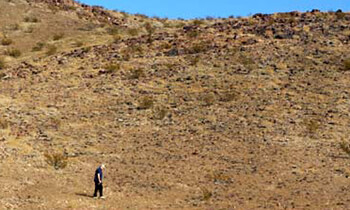Dune Evening Primrose
Oenothera deltoides
Desert Primrose - Birdcage Evening Primrose
Devil's Lantern - Lion-in-a-Cage - Basket Evening Primrose

This bushlike, sweet-scented annual is most often a grayish green, creeping dune plant growing 2 to 18 inches high and spreading as wide as 40 inches.
Sparse, pale green, hairy leaves grow as long as 4 inches, mostly on the ends of stalks emerging from a dense basal rosette. The long, oval leaves are often lobed, toothed, grooved or cleft.
This member of the Onagraceae (evening primrose) family, has many varieties and subspecies, accounting for its numerous common names.
- Desert Primrose
- Birdcage Evening Primrose
- Devil's Lantern
- Lion-in-a-Cage
- Basket Evening Primrose
When some of these some varieties die, the outer stems curl upward and inward, forming a cage-like shape.
Dune evening primrose grow profusely in the spring after abundant winter rains, making the early morning desert appear as if its covered with tissue paper. This plant is pollinated by the long-tongued, white-lined sphynx moth (Hyles lineata).
Range
Mojave, Sonoran and Great Basin deserts of southern California, Nevada, Arizona and Utah.
Habitat
Sandy, open desert areas, especially near dunes, below 3500 feet.

Flowers
Diaphanous, white, 4-petaled flowers forming a saucer, turn yellow toward the center. They bloom 1-1/2 to 3 inches wide, January through May. Flowers open in the early evening and close in mid-morning. They turn pinkish with age.
-- A.R. Royo
We have an online wildflower field guide that is designed to help you identify desert wildflowers by color, scientific name, region and common name. The pictures are sized to work on the iPod, iPhone, iPad and similar devices. With your iPod or phone you will easily be able to identify wildflowers while in the desert. Links for downloads are on the bottom of the Wildflower Field Guide page.
Photo tips: Most digital point-and-shoot cameras have a macro function - usually symbolized by the icon of a little flower. When you turn on that function, you allow your camera to get closer to the subject, looking into a flower for example. Or getting up close and personal with a bug. More on desert photography.
Mojave Desert Wildflowers - This book is the standard by which all other wildflower books are measured. The author, Jon Mark Stewart, has combined super photography with concise information. This book has an entire color page for each wildflower covered, with a discussion of the wildflower. 210 pages with 200 color photos. More...
What's Blooming Now - Check the Wildflower Reports
Share this page on Facebook:
The Desert Environment
The North American Deserts
Desert Geological Terms







